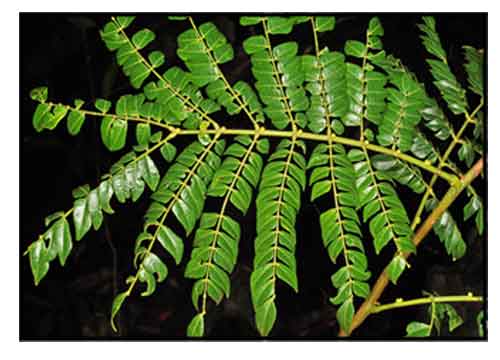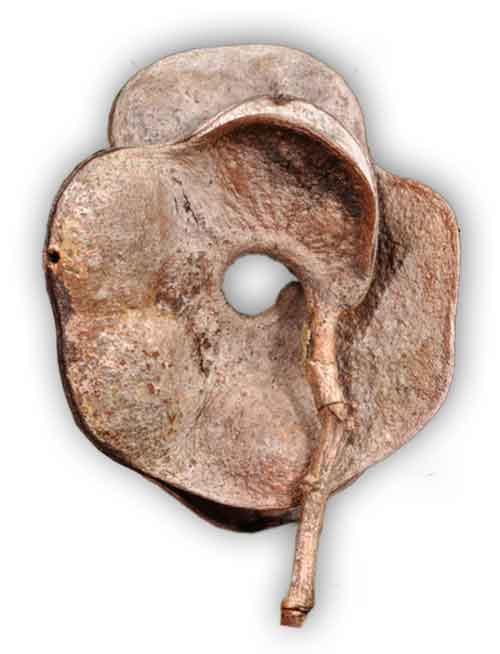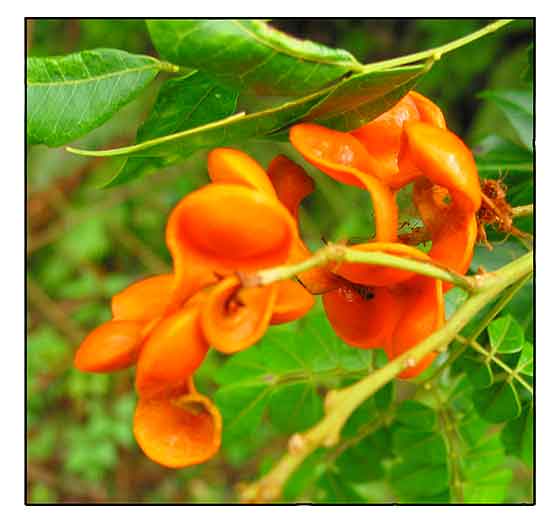 Gen info Gen info
- Archidendron is a genus of flowering plants in the pea family, Fabaceae, which includes 98 species ranging from India through Indochina, souther China, Taiwan, Malesia, and Papuasia to Queensland and New South Wales. (2)
- Etymology: The genus name Archidendon derives from Greek words archi, primitive, and dendron, tree. The species name clypearia derive from Lain, referring to a small round Roman shield, a reference to the use of the wood in making sheaths of weapons. (3)
Botany
• Trees, to 10 m tall. Branchlets angulate, densely yellow tomentose. Leaf petiole 4-angulate; leaf rachis and base of petiole with glands; glands flat or hollow; pinnae (3 or)4 or 5(-8) pairs, densely yellow tomentose, lowermost pinna with 3-6 pairs of leaflets, uppermost one with 10-12 pairs of leaflets; leaflets subsessile, adaxially shiny, oblique, rhombic-trapezoid, 1-7 × 0.7-3 cm, upper one largest, downward smaller, leathery, both surfaces slightly brown pubescent, base very unequally sided. Corymbs several flowered, arranged in terminal or axillary panicles. Flowers pedicellate. Calyx campanulate, 1-3 mm, 5-toothed, calyx and corolla densely brown villous. Corolla white or yellowish, 4-5 mm; lobes lanceolate. Stamens ca. 2 × as long as corolla, staminal tube equaling corolla tube. Ovary stipitate, hairy. Legume twisted, 1-1.5 cm wide, margin constricted between seeds. Seeds 4-10, black, ellipsoidal or broadly ellipsoidal, ca. 1 cm; testa wrinkled when dry. (Flora of China)
 • Growth form: A much-branched and medium-sized tree up to 22 m tall. Foliage: Alternate, long-stalked, bipinnate leaves possess 3–14 pairs of leaflets. The lowermost leaflet bears 3–6 pairs of leaflets, while the uppermost bears 8–14 pairs of papery leaflets that are opposite, diamond-shaped, and 1–7.6 by 0.7–3.8 cm. The leaflets gradually decrease in size towards the lowermost leaflet. • Growth form: A much-branched and medium-sized tree up to 22 m tall. Foliage: Alternate, long-stalked, bipinnate leaves possess 3–14 pairs of leaflets. The lowermost leaflet bears 3–6 pairs of leaflets, while the uppermost bears 8–14 pairs of papery leaflets that are opposite, diamond-shaped, and 1–7.6 by 0.7–3.8 cm. The leaflets gradually decrease in size towards the lowermost leaflet.
Flowers: Stalked flowers are white to yellowish, and develop up to 10 together in clusters. The clusters are arranged in shoots more than 30 cm-long, at the older leaf’s angles, or on leafless portions of twigs.
Fruits: Fruits are orange and red, 1–1.5 cm wide, spirally twisted legumes that contain 4–10 seeds. Its seeds are black, oval, up 1 cm wide, and wrinkled when dry. (3)
Distribution
- Native to the Philippines.
- Also native to Andaman Is., Assam, Bangladesh, Borneo, Cambodia, China South-Central, China Southeast, East Himalaya, Hainan, India, Jawa, Laos, Malaya, Maluku, Myanmar, Nepal, New Guinea, Nicobar Is., Sri Lanka, Sulawesi, Sumatera, Taiwan, Thailand, Vietnam. (1)
 Constituents Constituents
- Study of methanol extract of A. clypearia isolated six compounds, including 1-octacosanol, docosenoic acid, daucosterol, methyl gallate, quercitrin and (−)-7-O-galloyltricetiflavan. (see study below) (4)
- Phytochemical analysis of methanol extract of leaves and twigs isolated two new chalcones, clypesides A-B (1,2), 13 flavonoid derivatives (3-15).
(see study below) (8)
- Study of leaves and twigs isolated five undescribed phenolics, pithecellobiumin C-G, along with thirteen known ones. (see study below) (10)
- Study of leaves and twigs of Ac reports on the isolation of a new dilignan, archidendronin A (1), along with one known sesquilignan (2). (see study below) (11)
- Chromatographic analysis ofchloroform extract yielded four compounds i.e., daucosterol,
1-octacosanol, docosenoic acid, and methyl gallate. (see study below) (14)
- Study of leaves and twigs isolated three pairs of furolactone-type lignan enantiomers, including two new compounds (1R,5S,6S)-Kachiranol (1a) and (1S,5R, 6R)-Kachiranol (1b) and four known compounds. (see study below) (15)
Properties
- Studies have suggest xanthine oxidase inhibitory, antibacterial, antidiabetic, anti-inflammatory, ß-amyloid aggregation inhibitory, sEH inhibitory, sucrase inhibitory, antioxidant, antibacterial, antioxidant properties.
Parts used
Stem bark, leaves, twigs, peels.
Uses
Edibility
- No information found on edibility.
Folkloric
- No reported folkloric medicinal use in the Philippines.
-
Decoction of stem bark used as poultice for abscesses. (3)
- Decoction of leaves used as bath water for treatment of scabies. Dried leaves used for wound healing.
Others
- Wood: Use for making weapon sheaths, boxes, coffins, knife and tool handles, joinery, and various light construction.
-
Bark: Use for making hair shampoo, and tanning fishing nets. (16)
- Leaves: Use for coloring and tannin of rattan. Reported used as cattle poison. (3)
- Staining: Leaves and bark used to stain cloth black. (16)
- Fuel: Wood can be used as fuel.
Studies
• Xanthine Oxidase Inhibitors: Study screened 311 methanol extracts form 301 Vietnamese herbs were screened for xanthine oxidase (XO) inhibitory activity and isolated XO inhibitor(s) from the most active plant. Extracts of Archidendron clyperaria, Smilax poilanei, Linociera ramiflora and Passiflora foetida exhibited greatest potency with IC50 values < 30 µg/mL. Extract of A. clypearia isolated six compounds, including 1-octacosanol, docosenoic acid, daucosterol, methyl gallate, quercitrin and (−)-7-O-galloyltricetiflavan. The compound (-)-7-O-galloyltricetiflavan showed most potent XO inhibitory activity with IC50 of 25.5 µmol/L. (4)
• Antibacterial / Antidiabetic: Study systematically evaluated the antibacterial and antidiabetic components of A. clypearia using a combination of analytical methods. Network pharmacology and molecular docking were used to predict the main target components of A. clypearia and enzyme inhibition sites of α-amylase and α-glucosidase. P15, P16, and P20 were found to be the antibacterial and antidiabetic active components. The inhibitory effect of P15 (7-O-galloyltricetiflavan) on six bacterial species may be mediated through the lipid and atherosclerosis pathway, prostate cancer, adherens junctions, and targets such as SRC, MAPK1, and ASKT1. Molecular docking showed 7-O-galloyl-tricetiflavan and 7,4'-di-O-galloyltricetiflavan (P16/P20) can bind to α-amylase and α-glucosidase pockets with binding energies lover than -6 kcal/mol. Study provides guidance for the development of antibacterial and antidiabetic products based on A. clypearia. (5)
• Anti-Inflammatory: Study evaluated the anti-inflammatory effects of a 95% methanol extract (Ac-ME) on the AP-1 activation pathway, which play a critical role in the production of prostaglandin (PG)-E2 in RAW264.7 cells and peritoneal macrophages and in induction of acute gastritis caused by HCl/EtOH. The Ac-ME reduced nuclear levels of total and phospho-forms of c-Jun, FRA-1, and ATF-2. The extract suppressed both production of PGE2 in lipopolysaccharide (LPS)-activated RAW264.7 and peritoneal macrophage cells and PGE2-dependent induction of gastritis lesion under HCl/EtOH exposure. HPLC analysis showed quercetin, which inhibits PGE2 production is an active component in AcME. Study suggests Ac-ME is an ethnomedicinal remedy with an IRAK1/p38/AP-1 targeted inhibitory property. (6)
• Anti-Inflammatory on DSS-Induced Colitis: Study evaluated the anti-inflammatory effects of 95% Ac-ME on the production of inflammatory mediators in RAW264.7 cells and peritoneal macrophages and on symptoms of colitis in mouse induced by dextran sodium sulphate (DSS). The Ac-ME dose-dependently suppressed the secretion of nitric oxide (NO) and prostaglandin-E2 (PGE2) from RAW264.7 cells and peritoneal macrophages stimulated by LPS. The AcME clearly reduced mRNS expression of iNOS, COX-2, and TNF-α by blockade of NF-kB activation and upstream signaling events containing protein tyrosine kinase activities of Src and Syk and the formation of molecular signaling complex including p85. Results showed remarkable inhibition of DSS-induced colitis through suppression of Src and IkBα phosphorylation. (7)
• sEH Inhibitors / Flavonoids / Leaves and Twigs: sEH (soluble epoxide hydrolase) is a member of the epoxide hydrolase family and is found primarily in the cytosol and peroxisomes of mammalian tissues including the liver, intestines and vascular tissues. Study of methanolic extract of leaves and twigs of Ac significantly inhibited sEH (soluble epoxide hydrolase) in vitro. Phytochemical analysis of water layer isolated two new chalcones, clypesides A-B (1,2), 13 flavonoid derivatives (3-15). All the flavonoid derivatives inhibited sEH (soluble epoxide hydrolase) enzymatic activity in a dose-dependent manner, with IC50s ranging from 10.0 to 30.1 µM. Kinetic analysis of compounds 4, 8-10, 12, 13, and 15 revealed compounds 8-10 were non-competitive, 4, 13 and 15 were mixed type, and 12 competitive inhibitor. Results suggest the flavonoid derivatives from Ac are potential sEH inhibitors. (8)
• Anti-ß-Amyloid Aggregation Activity / Triterpenes / Leaves and Twigs: Study of twigs and leaves isolated a new triterpene and five known compounds. The isolated compounds were evaluated for inhibition of ß-amyloid aggregation by ThT-based fluorometric assay. Compound 3 (67.8%) and 6 (77.7%) exhibited higher inhibitory activity than positive (48.0%). (9)
• Neuroprotective / Leaves and Twigs: Study of leaves and twigs isolated five undescribed phenolics, pithecellobiumin C-G, along with thirteen known ones. The compounds were tested for neuroprotective activities against H2O2-induced injury in human neuroblastoma SHJ-SY5Y cells by MTT assay. Pithecellobiumin C-E exhibited noticeable neuroprotective effect, preventing cell death through inhibition of apoptosis induction. Flow cytometric studies showed the compounds could attenuate reactive oxygen species (ROS) level and mitochondrial dysfunction in SH-SY5Y cells. (10)
• Dilignan / Anti-ß-Amyloid Aggregation Activity / Leaves and Twigs: Study of leaves and twigs of Ac reports on the isolation of a new dilignan, archidendronin A (1), along with one known sesquilignan (2). Inhibitory activity on Aß1-42 aggregation was screened by ThT assay with curcumin as positive control. Compounds 1 and 2 showed inhibition rate of 60.0% and 64.4% at 20 µM, respectively. (11)
• Anti-Inflammatory on AP-1 Activation Pathway: Study evaluated the anti-inflammatory mechanism of 95% methanol extract (AcME) on AP-1 activation pathway. Results showed AcME reduced nuclear levels of total and phospho-forms of c-Jun, FRA-1, and ATF-2. The AcME suppressed both production of PGE2 in LPS-activated RAW264.7 and and peritoneal macrophage cells and PGE2=dependent induction of gastritis lesion under EtOH/HCl exposure. The AcME blocked the enzyme activity of IRAK1, indicating the enzyme is an inhibitory target of AcME and is involved in the suppression of the AP-1 pathway. HPLC analysis showed quercetin, which inhibits PGE2 production, is an active component in AcME. (12)
• Inhibition of Intestinal Sucrase / Antidiabetic Potential / Leaves and Twigs: A methanolic extract of leaves and twigs of A. clypearia significantly inhibited rat intestinal sucrase in vitro. A phytochemical analysis of aqueous layer isolated 14 compounds (1-14). The ME and water layer at concentration of 3.0 mg/mL showed potent sucrase inhibitory activity with 67.7 and 95.33% inhibition, respectively. Compounds 6, 7, and 10 (1.0 mM) showed potent sucrase inhibition (88.36, 81.57, and 66.32 % inhibition). Results suggest the sucrase inhibitory activity may provide novel opportunity for a new class of antidiabetic agents. (13)
• Antioxidant / Aerial Parts: In vitro study of methanol extract for antioxidant activity on isolated liver cells of mice showed ED50 of 2.18 µg/mL compared to curcumin at 1.87 µg/mL. Chromatographic analysis yielded four compounds from the chloroform extract i.e., daucosterol, 1-octacosanol, docosenoic acid, and methyl gallate. All four compounds showed high antioxidant activity, with methyl gallate showing highest one. (14)
• Enantiomeric Furolactone-Type Lignan / Anti-ß-Amyloid Aggregation Activity: Study of leaves and twigs isolated three pairs of furolactone-type lignan enantiomers, including two new compounds (1R,5S,6S)-Kachiranol (1a) and (1S,5R, 6R)-Kachiranol (1b) and four known compounds. All compounds were evaluated for inhibitory effects on ß-amyloid aggregation by ThT assay. Compound 1b showed 71.1% inhibitory activity, higher than positive control (61.0%) and other compounds. (15)
• Amelioration of Imiquimod-Induced Psoriasis / Aerial Parts: Study sought to clarify the protective effects of ethanol fraction of water extract (ESW) of Pithecellobium clypearia against psoriasis-like skin inflammation induced by imiquimod (IMQ) in mice with efficacy indexes and target tissue (spleen and serum) metabolomics. The ESW was composed mainly of gallic acid, ethyl gallate, quercitin, 7-O-galloyltricetiflavan, quercetin, and myricetin by UHPLC-MS/MS analysis. ESW distinctly improved IMQ-induced psoriasis in mouse by reducing PASI score, alleviating tissue damage, restoring spleen index, and inhibiting proliferating cell nuclear antigen (PCNA) expression in psoriasis-like skin tissue. Results showed ESW had obvious antipsoriasis effect on IMQ-induced psoriasis in mice, which may be attributed to regulation of dysfunction of differential biomarkers and related pathways. (17)
• Comparative Study / Radical Scavenging / Phenolic and Flavonoid Contents / Antibacterial / Peels: Study evaluated the radical scavenging activity, flavonoid and phenolic contents of of Archidendron clypearia peels and 13 other medicinal plants and dried tea leaves (green tea, oolong tea and black tea). The aqueous extract of A. clypearia showed growth inhibition of all tested enteric pathogenic bacteria (E. coli, S. typhi, S. dysenteriae. S. aureus, and V. cholera). On radical scavenging activity against DPPH free radicals, the aqueous and ethanolic extracts of A. clypearia showed greatest antioxidant activity to inhibit DPPH radicals with values of 138.48 and 233.33 mg GAE/g extract, total phenolic content of 109.14 and 123.70 mg GAE/g extract, and total flavonoid content of238.54 and 12.03 mg QUE/g extract, respectively, compared to green tea at 80.38, 116.15, 12.86, 101.57, 105.42 and 409.42, respectively.
Availability
Wild-crafted. |

![]()






